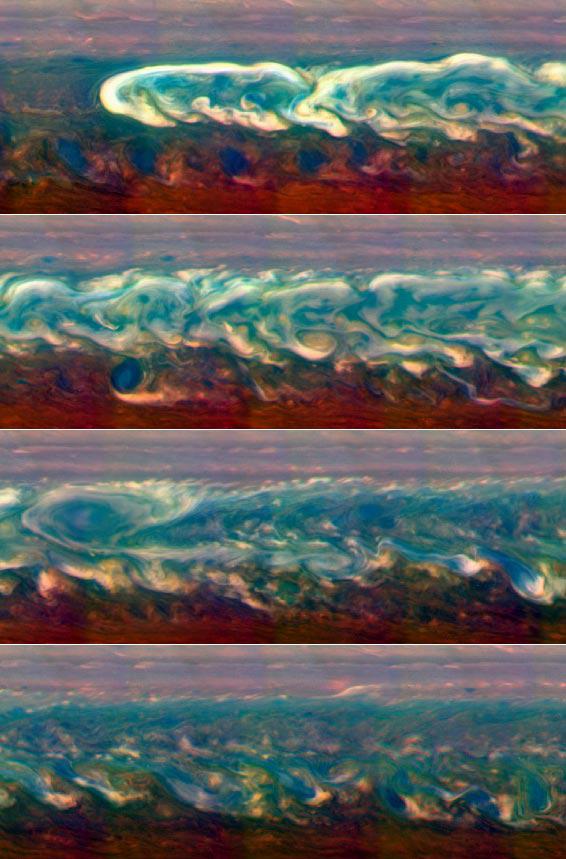In late 2010, Saturn got a bit of acne. A white spot appeared in its northern hemisphere, around the same latitude on Saturn that San Francisco is here on Earth. The spot quickly grew and became a full-fledged storm.
This happens frequently on the ringed planet, but in this case the storm forgot to stop. It grew, and grew, and rapidly became a monster, a storm so vast it was shocking scientists who had studied the planet for years. Whipped by winds in the upper Saturnian atmosphere, it stretched out and out, eventually, ridiculously, lengthening until it literally wrapped all the way around the planet. At its peak, it was over 300,000 km (180,000 miles) long—3/4 of the distance from the Earth to the Moon!
This new image from the Cassini spacecraft (below) shows the storm at its height of glory. The image was so long I decided to slice it up into four sections and stack them so you can see it more easily. The head of the storm is on the left in tthe top slice, and near the middle of the storm (third slice down on the left) is a huge cyclone spun off by the upwelling air. The image has been color enhanced to see details better, but white stuff is high in Saturn’s air, and darker material is where you penetrate deeper into the planet’s atmosphere. Saturn, remember, is a gas giant, basically a world that’s all atmosphere. It’s nearly 10 times wider than Earth, too, so that’s a whole lot of gas to play with.

Image credit: NASA/JPL-Caltech/Space Science Institute
The storm persisted for months, and then fizzled out. Scientists poring over the data have now shown the cause of the storm’s eventual, protracted death was…self-cannibalism. It ate its own tail.
The series of photos from the Cassini spacecraft (below) shows the progress of the storm over time (it’ll be easier to see this in the much bigger version of the picture). The red triangle marks the head of the storm, and the yellow triangle its tail. Over time, the head drifted westward rapdily while the tail moved more slowly, stretching out the storm. By May 2011 it wrapped halfway around the giant planet, and by June the tail and head were on a collision course. Shortly after that, once they overlapped, the storm died.

Image credit: NASA/JPL-Caltech/Space Science Institute
It’s not clear why, though the fact that the tail and head collided must be involved. Perhaps turbulence from the tail’s wake disrupted the head, or the mixing of the two ends of the system weakened it enough to dissipate it. Saturn storms are complex, involving heat welling up from the interior (which this storm had in spades), winds from higher and lower latitudes, and Saturn’s vast and powerful Coriolis force, magnified by its immense size and rapid rotation (a day on Saturn is a mere 10.5 hours long).
The power of this storm is hard to grasp. Besides its tremendous length, it also featured a huge upwelling of air so immense it would have sucked the Earth’s atmosphere clean off in about five months. That’s a huge flow of air. But then, at its largest the head of the storm was the size of Earth itself.
Seriously. Holy crap.

Image credit: NASA/JPL-Caltech/Space Science Institute
I love stuff like this. Love love love. It’s so easy to think of astronomical objects as far-off points of light in the sky, distant and untouchable. But they’re not. Saturn is a world, and more than that, we have an enduring presence there. Cassini entered orbit around the ringed planet in June 2004, and has sent thousands upon thousands of images and other data back to us here on Earth. We’ve learned as much about this planet in the past decade as we have since Galileo first saw it through a telescope—discovering the rings in the process, though he wasn’t exactly sure what he was seeing.
And that’s still true today, in a way. The Saturn system is so fiercely complex there is much of it we still don’t understand. Even if Cassini hadn’t taken some of the most gorgeous images in all of astronomy, Saturn would still be a favorite. It compels our eyes and our brain, and has mysteries and wonders to last for generations.
